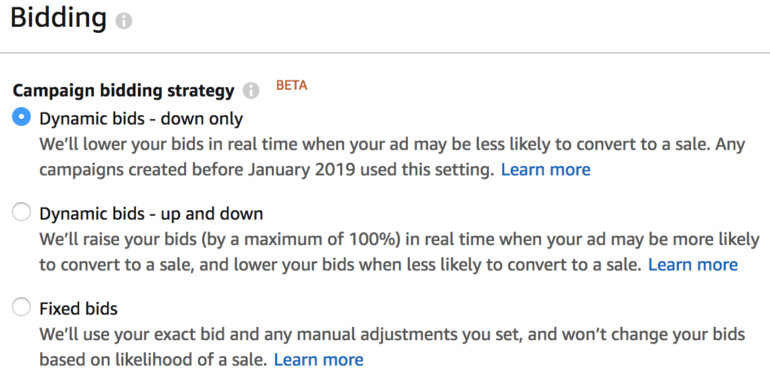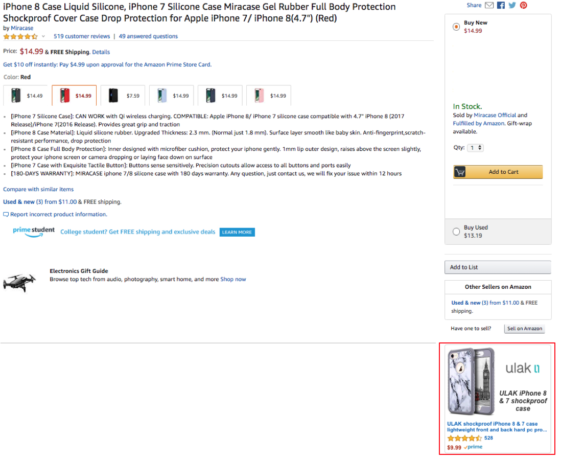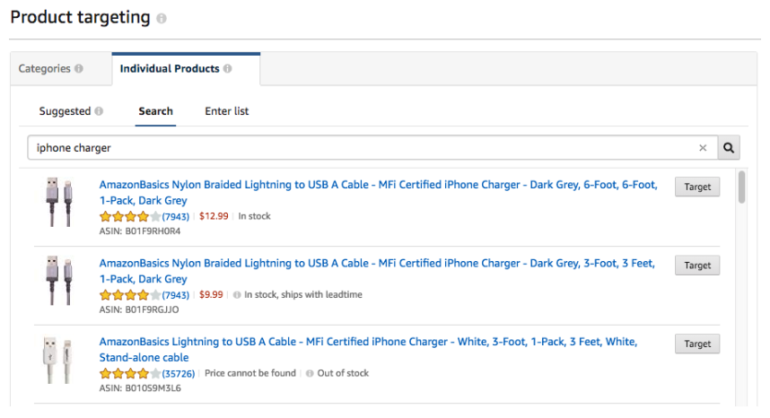[ad_1]
Amazon is continuing to improve their platform as they take more and more of the digital advertising market share. Coming in hot in January, Amazon has released a number of new Sponsored Products features across all Amazon advertising accounts. These new features, which include bidding strategies, placement multipliers, and new targeting options, introduce an additional layer of complexity to the Amazon marketplace. Luckily, we are here to break it down and help you understand these new features and how to best implement them in your accounts.
The Betas
Each of the newly released features is still technically in beta, but considering the fact every advertiser now has these options at their disposal, I would assume it is the tail-end of the beta testing. The features are specific to Sponsored Products ads, which makes sense as they are the best performing ads and most popular ads on Amazon. The new features are as follows:
- Bidding Strategies
- Placement Multipliers
- Product Targeting
- Enhanced Automatic Targeting
Bidding Strategies
You now have bidding strategy options beyond setting and adjusting the default bid. There are now two Dynamic bid options, down-only bidding and up-and-down bidding, as well as an old-fashioned Fixed Bid option.
Starting with the down-only dynamic bidding, this strategy is the default for all campaigns created before January 2019. It is the default bid option in Amazon. With this dynamic bid type, Amazon lowers your bids in real time if your ad is less likely to convert a sale. This is a conservative bidding type and I would recommend running it if you are on a limited budget.
If you have extra testing budget, I would recommend trying the up-and-down dynamic bidding strategy. For this strategy, Amazon raises your bids by a maximum of 100% if you are likely to convert a sale and lowers your bids when you are less likely to make a sale. This strategy puts a lot of faith into Amazon’s algorithms. I would recommend testing this strategy on one or two of your top-performing campaigns. This might seem counter to logic, as you don’t want to risk your best performers, but you want to give the algorithm plenty of data to use. The more conversions a campaign has, the more likely it optimizes for more sales moving forward.
If trusting Amazon to choose your bids doesn’t sound like your cup of tea, then the fixed bids option is the best for you. With this option, Amazon uses your exact bid and any manual adjustments you set. It does not change your bids on the likelihood of a sale. If you have very specific CPCs in mind for your products, this is definitely your play to make.
Placement Modifiers
In addition to the bidding strategies are placement modifiers. The placement modifiers add an additional layer of bid multipliers to help your ads show when you want them to show. There are two placement modifier options, top of search and product pages. For both, you can set the option to increase your bids by up to 900% to ensure placement for both options.
The top of search modifier would let you increase your bid to help your ad stay top of page. The higher the percentage, the more likely your ad stays top of page. However, the downside is that you will likely spend much more on your clicks. A $1.00 bid set with a 900% modifier could cost you up to $9 if someone clicked your top of page ad. For this modifier, I would recommend running this modifier on your branded campaigns that consist of your branded keywords to make it harder for your competitors to show above your products. After letting the modifier run for a week or two, you can run two placement reports comparing the previous period to the new period. This should show you how your top of page placements increased and how much the CPC has increased.
The product pages modifier shows how much you are willing to increase your bid to be shown on product pages. The product pages are where customers view individual products. On product pages, the ad shows below the buy box.
This type of ad space typically goes to Product Display ads, which are only available to AMS Vendor Central advertisers. However, sponsored product ads can also take this space, if less often, which leads to the modifier showing how willing you are to have your ads appear on product pages. You would want to use this modifier for two types of campaigns – competitor and complimentary. For competitors, you would want to increase the modifier so you can show on their product pages and take away customers from their products. You could also increase this modifier if you have a product that goes well with another product. For instance, if you sold sunscreen you might increase this modifier on a campaign targeting beach towels, as the products are likely commonly bought together.
Product Targeting
Once you have your bids and modifiers all set up, you can next test new targeting options for sponsored product ads. Product targeting is an option for manual campaigns that allow you to target by ASIN or product category. Previously, you could only target by keywords for sponsored product ads. This new method of targeting can give you greater control over where your ads show.
Product targeting can be another tool for targeting competitors efficiently. You can find competitor products that have poor reviews and ratings, target those specific ASINs, and then advertise your best products against their poor performers. Combine this method of targeting with a high product pages placement modifier and you have a campaign that is all but guaranteed to show on competitor product pages.
If you do not have strong competition on Amazon, this is another targeting option that is great for complimentary advertising. Like with the competitor strategy, you target specific ASINs and increase the product pages placement multiplier to show more often on the ASINs you targeted. Only this time, instead of competitors, you are targeting product ASINs that your product makes sense to be purchased alongside. If you sell spatulas, you might target grills or target desks if you are an office supplier. If it makes sense for your products to be purchased together, test targeting it.
Conclusion
Only a month into 2019 and Amazon is already making changes to improve the advertising capabilities on its platform. I expect this is just the beginning to a year of changes on Amazon Advertising. It is only going to get more complex as we go along, but with that complexity finding the right audience at the right time for your products will only get easier. What I find most interesting about these latest changes are how well they work together. The bid modifiers give advertisers options for how aggressive they want to push their campaigns and there are advanced options with the placement modifiers. On top of that, the modifiers then compliment the new product targeting strategy. Used well, the bids and modifiers implemented alongside the product targeting should only increase the likelihood of your campaign succeeding.
Have you tested the new bidding options and multipliers? What about the product targeting? How has it all performed for you? Let me know on Twitter!
[ad_2]
Source link







Recent Comments